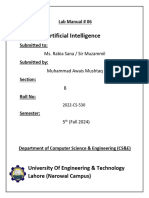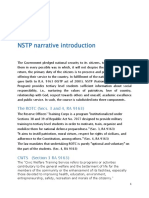Assignment - Capacitors
Uploaded by
asmonovAssignment - Capacitors
Uploaded by
asmonovHCT. BTEC.
Assessment Centre Number 024150
Course: : BTEC Level 3 Subsidiary Student:
Diploma in Engineering / Diploma in
Electrical/Electronic Engineering
Unit/s: 6 – Electrical & Electronic Principles
Outcome/s: 2 - Capacitance
Grading criteria:
P4 Describe the types and function of capacitors.
P6 Calculate the charge, voltage and energy values in a DC network for both three
capacitors in series and three capacitors in parallel.
M2 Evaluate capacitance, charge, voltage and energy in a network containing a series-
parallel combination of three capacitors.
Pass: Merit: Distinction:
Instructions:
• All work is to be your own.
• Attempt all questions.
• Work to be legible and succinct, with an adequate grasp of grammar,
punctuation and spelling.
• Calculators may be used but show working step by step.
• Ensure sketches & diagrams are clear, accurate & labelled.
• True graphs, titled & axes labelled.
• List sources where appropriate.
Student feedback:
Student declaration – The assignment attached is my own work.
Signed: Date:
Assessor feedback:
Signed: Date:
Internal verification Issue date Student hand in date Internal verification
(Before issue) (assessment decision)
CRT 10/11/10
Unit 6: Electrical & Electronic Principles Page 1 of 4
Assignment - Capacitors
HCT. BTEC. Assessment Centre Number 024150
Grading Criteria and Feedback
P4 Describe the types and function of capacitors.
Task 1
P6 Calculate the charge, voltage and energy values in a DC network for
both three capacitors in series and three capacitors in parallel.
Task 2 & 3
M2 Evaluate capacitance, charge, voltage and energy in a network
containing a series-parallel combination of three capacitors
Task 4
Unit 6: Electrical & Electronic Principles Page 2 of 4
Assignment - Capacitors
HCT. BTEC. Assessment Centre Number 024150
Assignment - Capacitors
Time allowed: 1½ hr.
This time limited theoretical assignment provides evidence for satisfaction of
the Grading Criteria P4 and P6, and the opportunity to achieve M2. The relevant
grading criteria are given in brackets after each task.
1. Complete the table below with typical properties and values. The entry for
mica capacitors has been included to get you started:
Capacitor Type
Property or feature
Mica Ceramic Polyester Polystyrene Electrolytic
Capacitance range (F) 0.47p – 22n
Typical Tolerance (%) ±1
Typical Voltage rating
350V
(W)
Temperature
+50
coefficient (ppm/°C)
Stability Excellent
Ambient temperature
-40 to +125
range (°C)
Typical applications Tuned
circuits and
oscillators
Use the information that you have obtained to answer the following questions:
a) Which type of capacitor is available with the largest capacitor values?
b) Which type of capacitor is available with the smallest capacitor values?
c) Which type of capacitor has the highest voltage rating?
d) Which type of capacitor has the closest tolerance?
e) Which type of capacitor has the smallest size for a given value?
f) Which type of capacitor would be suitable for:
a. Tuning a radio receiver?
b. Acting as a ‘reservoir’ capacitor in a power supply?
(P4)
Unit 6: Electrical & Electronic Principles Page 3 of 4
Assignment - Capacitors
HCT. BTEC. Assessment Centre Number 024150
2. Capacitances of 1µF, 3µF and 6µF are connected in series across a 270V
supply. Calculate:
a) The equivalent circuit capacitance,
b) The charge on each capacitor,
c) The p.d. across each capacitor, and
d) The energy stored in each capacitor.
(P6 part)
3. Capacitances of 4µF, 8µF and 16µF are connected in parallel across a 300V
supply. Calculate:
a) The equivalent circuit capacitance,
b) The charge on each capacitor,
c) The p.d. across each capacitor, and
d) The energy stored in each capacitor.
(P6 part)
4. The circuit below shows a network of three capacitors. Determine the
following:
(a) the value of one single capacitor that could replace the three
capacitors.
(b) the potential difference that will appear across each capacitor
(c) the charge present in each capacitor
(d) the energy stored in each capacitor
(e) the total energy stored in the circuit
C1
45µF
240V
C2 C3
68µF 22µF
Show all of your workings and state clearly the relationships on which you
have based your calculations.
(M2)
Unit 6: Electrical & Electronic Principles Page 4 of 4
Assignment - Capacitors
You might also like
- M05 BTEC National Applied Science Student B2 Unit 5No ratings yetM05 BTEC National Applied Science Student B2 Unit 570 pages
- Service Manuals LG TV LCD 42LG61YD 42LG61YD Service ManualNo ratings yetService Manuals LG TV LCD 42LG61YD 42LG61YD Service Manual45 pages
- Las Individualidades Espirituales de Los Planetas PDFNo ratings yetLas Individualidades Espirituales de Los Planetas PDF15 pages
- EE 251: Basic Electrical Engineering: Spring 2021 - Section: DA Week 6No ratings yetEE 251: Basic Electrical Engineering: Spring 2021 - Section: DA Week 657 pages
- Physics Investigatory Project: Kendriya Vidyalaya No.1 Air Force Station Sector-14 GurugramNo ratings yetPhysics Investigatory Project: Kendriya Vidyalaya No.1 Air Force Station Sector-14 Gurugram19 pages
- BTEC National Certificate in Electronics: Brendan BurrNo ratings yetBTEC National Certificate in Electronics: Brendan Burr15 pages
- Eeeb113 Circuit Analysis 1: Chapter 6: Capacitors and Inductors Sharifah Azma Syed Mustaffa100% (1)Eeeb113 Circuit Analysis 1: Chapter 6: Capacitors and Inductors Sharifah Azma Syed Mustaffa25 pages
- Sage University Indore: Department of Computer Science and Information TechnologyNo ratings yetSage University Indore: Department of Computer Science and Information Technology50 pages
- Bsc102c Tutorial Topic12 v1.8 QuestionsNo ratings yetBsc102c Tutorial Topic12 v1.8 Questions76 pages
- Impedance Spectroscopy: Theory, Experiment, and ApplicationsFrom EverandImpedance Spectroscopy: Theory, Experiment, and ApplicationsEvgenij BarsoukovNo ratings yet
- Electromagnetic Compatibility (EMC) Design and Test Case AnalysisFrom EverandElectromagnetic Compatibility (EMC) Design and Test Case AnalysisNo ratings yet
- Physics Project Made By: J.Sanurag Class 12 A Army Public School Charging and Discharging of CapacitorNo ratings yetPhysics Project Made By: J.Sanurag Class 12 A Army Public School Charging and Discharging of Capacitor12 pages
- Topic 3 Electrostatic Current and CapacitorsNo ratings yetTopic 3 Electrostatic Current and Capacitors34 pages
- AC Circuit Analysis: Reading: Chapter 5, 6, 9,10,11 Textbook: Fundamental of Electric Circuits TextbookNo ratings yetAC Circuit Analysis: Reading: Chapter 5, 6, 9,10,11 Textbook: Fundamental of Electric Circuits Textbook134 pages
- ECE422L Activity No. 04 Capacitors and Capacitance MarasiganAA, UmaliGCDNo ratings yetECE422L Activity No. 04 Capacitors and Capacitance MarasiganAA, UmaliGCD19 pages
- PHY221 Lecture 4 Capacitance and DielectricsNo ratings yetPHY221 Lecture 4 Capacitance and Dielectrics47 pages
- Unit 6: Electrical and Electronic PrinciplesNo ratings yetUnit 6: Electrical and Electronic Principles16 pages
- 392875865-Capacitors-Investigatory-Project RRTNo ratings yet392875865-Capacitors-Investigatory-Project RRT20 pages
- Coronavirus Replication and Reverse Genetics (Current Topics in Microbiology and Immunology) PDFNo ratings yetCoronavirus Replication and Reverse Genetics (Current Topics in Microbiology and Immunology) PDF261 pages
- Fourier Analysis Technique: Engineering Signals & Systems by Ulaby & YagleNo ratings yetFourier Analysis Technique: Engineering Signals & Systems by Ulaby & Yagle4 pages
- Solar-Powered Evaporative Air-Conditioner: by Jeffrey James SnelgarNo ratings yetSolar-Powered Evaporative Air-Conditioner: by Jeffrey James Snelgar156 pages
- Unit 103 Further Mathematics For Engineering TechniciansNo ratings yetUnit 103 Further Mathematics For Engineering Technicians13 pages
- Implementation of Frequency Demodulator Using The PLL Demodulation MethodNo ratings yetImplementation of Frequency Demodulator Using The PLL Demodulation Method4 pages
- Component-Level Electronic-Assembly Repair (CLEAR) Spacecraft Circuit Diagnostics by Analog and Complex Signature AnalysisNo ratings yetComponent-Level Electronic-Assembly Repair (CLEAR) Spacecraft Circuit Diagnostics by Analog and Complex Signature Analysis37 pages
- NWU - ACA - 010 Syllabus Pagpapahalagang Pampanitikan100% (1)NWU - ACA - 010 Syllabus Pagpapahalagang Pampanitikan11 pages
- Alba - Mary Jeanina - Reflection Paper #2No ratings yetAlba - Mary Jeanina - Reflection Paper #22 pages
- Artificial Intelligence: Lab Manual # 06No ratings yetArtificial Intelligence: Lab Manual # 0610 pages
- Reading The Most Dangerous Game by Harold Brodkey: Robert Jan M. ReyesNo ratings yetReading The Most Dangerous Game by Harold Brodkey: Robert Jan M. Reyes8 pages
- Perspectives: Scientific Machine Learning BenchmarksNo ratings yetPerspectives: Scientific Machine Learning Benchmarks8 pages
- Lohana Schools: P.2 English Revision Work Activity One: 2020No ratings yetLohana Schools: P.2 English Revision Work Activity One: 20209 pages
- Summary of the interview with Australian biologist Jeremy GriffithNo ratings yetSummary of the interview with Australian biologist Jeremy Griffith9 pages
- Updated Bandolera Constitution Appendix B - Demerit SystemNo ratings yetUpdated Bandolera Constitution Appendix B - Demerit System3 pages
- Dog Breed Identification: Whitney Larow Brian Mittl Vijay SinghNo ratings yetDog Breed Identification: Whitney Larow Brian Mittl Vijay Singh7 pages
- Developing Online Application With Kivy A Python FrameworkNo ratings yetDeveloping Online Application With Kivy A Python Framework6 pages
- Problem Solving Strategies by Arthur AngelNo ratings yetProblem Solving Strategies by Arthur Angel128 pages
- A) Choose The Correct Answer. 1) 2) 3) 4) 5) 6) 7) B) Fill in The Blanks With "There Is - There Are" 1) 2) 3) 4) 5) 6) 7) 8)No ratings yetA) Choose The Correct Answer. 1) 2) 3) 4) 5) 6) 7) B) Fill in The Blanks With "There Is - There Are" 1) 2) 3) 4) 5) 6) 7) 8)1 page
- University College Kuliyapitiya - Application Form: Post Applied ForNo ratings yetUniversity College Kuliyapitiya - Application Form: Post Applied For4 pages
- M05 BTEC National Applied Science Student B2 Unit 5M05 BTEC National Applied Science Student B2 Unit 5
- Service Manuals LG TV LCD 42LG61YD 42LG61YD Service ManualService Manuals LG TV LCD 42LG61YD 42LG61YD Service Manual
- Las Individualidades Espirituales de Los Planetas PDFLas Individualidades Espirituales de Los Planetas PDF
- Electromagnetic Foundations of Electrical EngineeringFrom EverandElectromagnetic Foundations of Electrical Engineering
- Immittance Spectroscopy: Applications to Material SystemsFrom EverandImmittance Spectroscopy: Applications to Material Systems
- EE 251: Basic Electrical Engineering: Spring 2021 - Section: DA Week 6EE 251: Basic Electrical Engineering: Spring 2021 - Section: DA Week 6
- Physics Investigatory Project: Kendriya Vidyalaya No.1 Air Force Station Sector-14 GurugramPhysics Investigatory Project: Kendriya Vidyalaya No.1 Air Force Station Sector-14 Gurugram
- BTEC National Certificate in Electronics: Brendan BurrBTEC National Certificate in Electronics: Brendan Burr
- Eeeb113 Circuit Analysis 1: Chapter 6: Capacitors and Inductors Sharifah Azma Syed MustaffaEeeb113 Circuit Analysis 1: Chapter 6: Capacitors and Inductors Sharifah Azma Syed Mustaffa
- Sage University Indore: Department of Computer Science and Information TechnologySage University Indore: Department of Computer Science and Information Technology
- Impedance Spectroscopy: Theory, Experiment, and ApplicationsFrom EverandImpedance Spectroscopy: Theory, Experiment, and Applications
- Electromagnetic Compatibility (EMC) Design and Test Case AnalysisFrom EverandElectromagnetic Compatibility (EMC) Design and Test Case Analysis
- Physics Project Made By: J.Sanurag Class 12 A Army Public School Charging and Discharging of CapacitorPhysics Project Made By: J.Sanurag Class 12 A Army Public School Charging and Discharging of Capacitor
- AC Circuit Analysis: Reading: Chapter 5, 6, 9,10,11 Textbook: Fundamental of Electric Circuits TextbookAC Circuit Analysis: Reading: Chapter 5, 6, 9,10,11 Textbook: Fundamental of Electric Circuits Textbook
- ECE422L Activity No. 04 Capacitors and Capacitance MarasiganAA, UmaliGCDECE422L Activity No. 04 Capacitors and Capacitance MarasiganAA, UmaliGCD
- Coronavirus Replication and Reverse Genetics (Current Topics in Microbiology and Immunology) PDFCoronavirus Replication and Reverse Genetics (Current Topics in Microbiology and Immunology) PDF
- Fourier Analysis Technique: Engineering Signals & Systems by Ulaby & YagleFourier Analysis Technique: Engineering Signals & Systems by Ulaby & Yagle
- Solar-Powered Evaporative Air-Conditioner: by Jeffrey James SnelgarSolar-Powered Evaporative Air-Conditioner: by Jeffrey James Snelgar
- Unit 103 Further Mathematics For Engineering TechniciansUnit 103 Further Mathematics For Engineering Technicians
- Implementation of Frequency Demodulator Using The PLL Demodulation MethodImplementation of Frequency Demodulator Using The PLL Demodulation Method
- Component-Level Electronic-Assembly Repair (CLEAR) Spacecraft Circuit Diagnostics by Analog and Complex Signature AnalysisComponent-Level Electronic-Assembly Repair (CLEAR) Spacecraft Circuit Diagnostics by Analog and Complex Signature Analysis
- NWU - ACA - 010 Syllabus Pagpapahalagang PampanitikanNWU - ACA - 010 Syllabus Pagpapahalagang Pampanitikan
- Reading The Most Dangerous Game by Harold Brodkey: Robert Jan M. ReyesReading The Most Dangerous Game by Harold Brodkey: Robert Jan M. Reyes
- Perspectives: Scientific Machine Learning BenchmarksPerspectives: Scientific Machine Learning Benchmarks
- Lohana Schools: P.2 English Revision Work Activity One: 2020Lohana Schools: P.2 English Revision Work Activity One: 2020
- Summary of the interview with Australian biologist Jeremy GriffithSummary of the interview with Australian biologist Jeremy Griffith
- Updated Bandolera Constitution Appendix B - Demerit SystemUpdated Bandolera Constitution Appendix B - Demerit System
- Dog Breed Identification: Whitney Larow Brian Mittl Vijay SinghDog Breed Identification: Whitney Larow Brian Mittl Vijay Singh
- Developing Online Application With Kivy A Python FrameworkDeveloping Online Application With Kivy A Python Framework
- A) Choose The Correct Answer. 1) 2) 3) 4) 5) 6) 7) B) Fill in The Blanks With "There Is - There Are" 1) 2) 3) 4) 5) 6) 7) 8)A) Choose The Correct Answer. 1) 2) 3) 4) 5) 6) 7) B) Fill in The Blanks With "There Is - There Are" 1) 2) 3) 4) 5) 6) 7) 8)
- University College Kuliyapitiya - Application Form: Post Applied ForUniversity College Kuliyapitiya - Application Form: Post Applied For








































































































